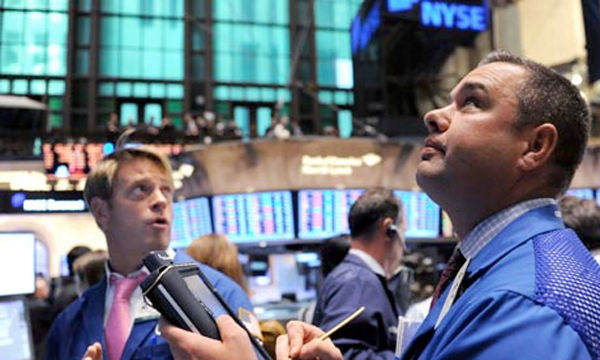Wall Street plummeted as concerns over European debt and the US economic downturn spurred a broad sell-off. Photograph: Shen Hong/Xinhua Press/Corbis
Read my article from Guardian Cif, Friday 19th August:
As bank shares and stock markets plummet, and investors flock to the safety of government bonds; as obstinate EU leaders crucify their countries in a futile struggle to defend today’s equivalent of the gold standard; as British and American politicians adopt austerity policies and drive their economies closer to the cliffs of depression; and as most professional economists stand aloof from the escalating crisis – what lies ahead for ordinary punters like you and me?
First, let’s take look at the big political picture. This crisis is already sharpening the divide between left and right in both the EU and the United States. Studying a precedent – the implosion of the 1920s credit bubble in 1929 – we note that four years after that crisis erupted, the political divide sharpened decisively. The United States and Britain moved to the left. Germany chose a different path. After 1930, Germany’s Centre party under Chancellor Brüning adopted austerity policies that resulted in cuts in welfare benefits and wages, while credit was tightened. At the same time the German government engaged in wildly excessive borrowing from the liberalised international capital markets. The ground was laid for the rise of fascism.
Four years after the “debtonation” of August 2007, our political classes in both the EU and the US have consciously declined to restrain out-of-control finance sectors or to fix broken, effectively insolvent banks. Instead, central bankers deployed taxpayer-backed resources (quantitative easing) to finance, guarantee and bail out bankers who then went on a wild, speculative spending spree.
At the same time, politicians imposed austerity on the more socially useful and productive sectors of the economy, both public and private. In both the EU and US these economic strategies have angered the populace and emboldened the right; in particular the far right. Looking ahead through the political lenses of austerity, street rioting and Tea Party obstructionism, the signs are ominous.
And then there is the impact on our own living standards. For comparisons and precedent, we need only look at Japan. Our politicians and central bankers have not learned from Japan’s crisis, which preceded our own. We are, therefore, destined to follow Japan’s disastrous record of lost decades of economic activity. As in Japan, so here: a broken banking system, crushed by the weight of unpayable debts on its balance sheet, fails to lend to businesses at affordable rates. Pretty soon this constrains investment. First-time buyers can’t get affordable loans or overdrafts, placing downward pressure on property prices.
A fall in investment is compounded by government policies for austerity – rises in VAT, and cuts in public spending. These policies trigger a rise in unemployment. Rising unemployment causes people to snap their purses shut, placing even further downward pressure on prices, profits, wages and employment. The downward spiral is then hard to arrest.
Property prices across Japan have continued to slide uninterrupted for nearly two decades. Hard though it may be for us to accept, it is not impossible to imagine UK property prices falling for the next two decades.
Just as here, Japan’s politicians and central bankers exaggerated the risks of inflation, reflecting the concerns of bankers and creditors – who fear inflation will erode the value of their outstanding loans. And so they were slow to a) use monetary policy to help the broader economy recover, and b) to restructure banks. The primary Keynesian tools for reversing the Great Depression were an aggressive monetary policy combined with extensive restructuring of the banking system.
While Keynes is largely defined (by his enemies) as a fiscal activist, he was first and foremost a monetary economist. In other words, he believed that if governments and central bankers would only fix the money system – by lowering rates of interest for all borrowers (not just the banks); by injecting QE into productive, socially useful projects; and by restructuring the banking system – the rest of the economy could be helped to recover.
Because our politicians and central bankers have so firmly rejected these lessons, prospects don’t look good for us at all. Instead, we would do well to echo Frank Zappa’s realism: “I mean to say that every day/Is just another rotten mess/And when it’s gonna change, my friend/Is anybody’s guess.”



For my (and any others who don’t know)education, i thought most of the developed world already had historically low interest rates as i write (with the exception of Australia). Has the margin between the banks and borrowers blown out somewhere.?
Were and are Japans lending rates to businesses and mums and dads high by historical standards.?
regards
Peter
The key figure in all this is George Osborne. Remember Margaret Thatcher in 1980, one year after the Tory victory in 1979, at the Tory Conference : “You turn if you want to. The lady is not for turning”. We can expect George Osborne, if not David Cameron, at the upcoming Tory conference to say : “You turn if you want to. The gentleman is not for turning.”
The bleakest cloud always has a silver lining. My belief is that the Tory monetarists, after 13 years in Opposition, are too proud to admit defeat now they are in power. However things will get so messy that in a year’s tima at most there will be a serious rethink at the highest levels of the Tory Party.